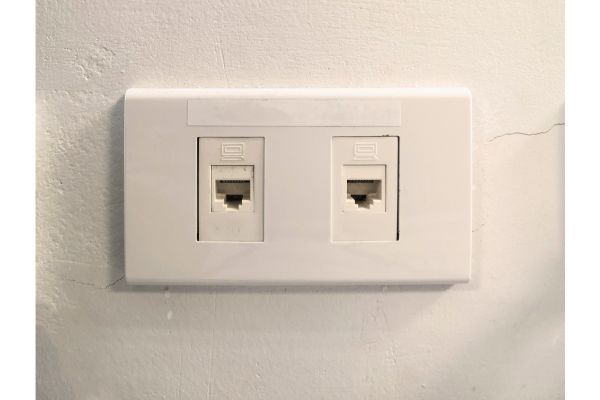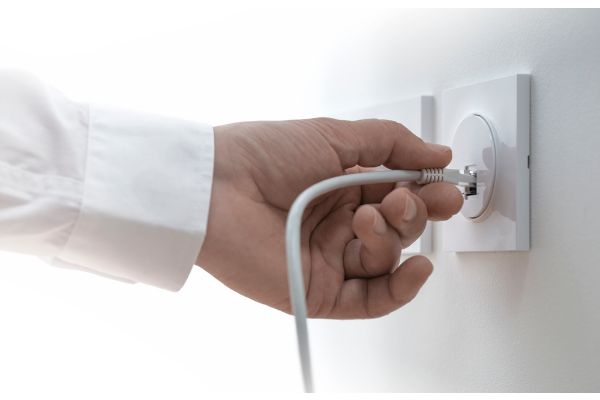Disclaimer: This post may contain affiliate links, meaning we get a small commission if you make a purchase through our links, at no cost to you. For more information, please visit our Disclaimer Page.
There is little question that the internet is a service almost everyone uses these days. Whether you need it in your home for a business you run, or you just want to connect to the web for entertainment and leisure, having the ability to access the internet right from your home is a must for most people. One of the key ways we do this is through wireless access.
Your internet service provider will set up hardware in your home, then it will bring a signal to that hardware. Once the signal branches out through different hardware, you’ll connect all of your favorite devices to it, and no wires will be necessary. Although this is a convenient way to get online, there is another one that involves a wired connection. The ethernet input allows you to use wires to connect your devices directly to the internet hardware in your home. It may feel less convenient, but it can also mean a more stable flow of data.
Some homeowners may wonder if all houses come with ports that will accept ethernet connections by default. In today’s article, we’ll answer this very question, and we will take it further to give you some extra information. Along the way, we’ll talk about whether the ports you might find have their own connections already once you move in, how the main hardware for ethernet might come into your home, how much it could cost you in order to bring something like this in, and what you might be able to do to get a Wi-Fi connection in lieu of an ethernet one.
Table of Contents
Do Houses Come With Ethernet Ports?
Many homes can come with their own ethernet ports already set, but it is not necessarily a given that this is true. In other words, some houses will have ports, but you may move into one that does not.
If you want to search your house for ethernet ports, you can look at the walls in every room. Even if you do have ethernet ports available, you may not find them in every room in the home. However, it is common to find them in rooms where people might be most likely to congregate and use devices.
To take a look for ports like these, you can look for small spots on the wall that have outlets. For ethernet, the characteristic outlet uses a jack known as the RJ45. If you are familiar with wired telephone jacks for old phones that are landlines, these would be RJ11 inputs.
The jack for the ethernet will look similar to these phone jacks, but it should be about twice the width of one. Some locations for ethernet ports might have more than one jack sharing the same outlet.
Are Ethernet Ports Connected in a House?
As with the previous answer, the ethernet ports in your home might have a connection already. However, if you’ve just moved to a new location and noticed the ethernet ports, you’ll still need to set up the internet service with a local provider before you can get online. Once you do this, yes, there is a place for the ethernet ports to connect to the wiring in the home.
In most cases, the ethernet ports terminate in a storage space like a utility closet, basement, or attic. You may find that all the cables converge into a single panel. Otherwise, you might find a junction box that you can open to view the wiring.
In either case, if you find wiring that reads Cat, it is probable that you have some ethernet connections in the home.
Ethernet wiring goes by categories. Although the precise category designation may not matter, you can look for examples such as Cat 5, Cat 5E, or 6 numbering and lettering that exists somewhere on the wire’s sheath. If you’ve found this, then you know you have ethernet ports that connect in the home.
All that said, the wiring for this sort of thing may not necessarily be active already. You might need to set up the connections with local providers before anything will work.
You may have cases where the wiring is old or in disrepair, just like any kind of electrical wiring might be in the home, too. Therefore, you should prepare for the possibility that the ethernet is not internet-ready in the home.
Do Internet Service Providers or Electricians Install Ethernet Jacks?
When we think of internet connections, it is logical to consider internet service providers first. After all, they are who you would call in order to get an active connection running into your home. This is particularly true of Wi-Fi.
Although an ISP will certainly make sure you have a good ethernet connection to, they are not necessarily who you should call if you need to install the actual infrastructure to get ethernet up and running. Some ISP companies might be able to do this, in theory, but it is more likely that they would coax you toward getting some of their hardware for Wi-Fi purposes.
It is also true that an ISP might not have the technical people necessary to set up ethernet jacks and related infrastructure.
It is much more likely that a qualified electrician will be able to do this job for you. They already have extensive experience with wiring jobs in general. If necessary, you can even look for an experienced low-voltage electrician.
This class of professional should have some specialized skills that translate well to installing what you need in a home for ethernet access. The reason that a low-voltage specialist is a good way to go has to do with the other kinds of work they might perform. Typically, such an expert is already knowledgeable in how to run lines for things like security alarms or cameras.
Additionally, if you cannot find a specialist like this, you can try a more generic electrician. They still know how to run lines for power, and they can probably set up things for ethernet just fine. The issue you might have here is that some things might not work correctly once the installation finishes.
For example, the general electrician may be able to set up the ports and run the cables adequately. However, they may use splitters or other hardware that is not compatible with what your internet service provider uses. In such circumstances, you may not know this until you try things out, further complicating your wired internet access.
How Much Does It Cost To Install Ethernet Ports in a House?
When you pick the kind of professional you’d like to go with, you’ll have to figure out a price that works within your budget. Although costs can vary quite a bit, most of what you will pay for depends on what you want to do and how you would like to do it. The professional in question will probably charge you an hourly rate to do the work for you.
Most of the costs you incur here will be because of the time and labor the expert has to put in, but there are particular tasks or extras that may tack on extra expenses to your initial quote.
For example, you could have the expert simply run lines, but most of the work they need to do will involve drilling into the walls to run cables. Once they do all of this, the total cost can also depend on things like whether you need plenum cables, faceplates, keystones at either end of the connections, and surrounds for low voltage. Additionally, don’t forget that the price can increase depending on how many cable drops you’d like them to install throughout the whole house.
While we cannot provide an exact quote here, most regions may charge at least a $100. This could be particularly true if you want to check off all the things on the above list, and if it takes the worker more than a couple of hours to complete the entire installation.
How Do I Get Wi-Fi if My House Doesn’t Have an Ethernet Port or One That Works?
Although ethernet may be more stable, modern internet service providers are well-equipped to help you get online relatively quickly through the use of a wireless connection. All you’ll need is a modem that you can pair with a router. In most cases, the ISP will provide the former. It is possible that you can also buy a router from them for a quicker setup, too.
All you need to do is contact a local provider of your choice and settle on a plan for the data you want. Once you do, a technician will set up and install the modem that the ISP will use to send the signal into your home.
After the connection establishes itself, your router can pick it up and send it out to let your devices connect to the internet without any cables. The technician may need to run some cables and connections in your home, too, but this is usually part of the service package for which you’ll pay before your contract starts.
Conclusion
Ethernet can be a nice way to get online and stay there securely. A connection using physical cables tends to be a bit more stable than a wireless one. However, not all homes have ethernet ports. Although you can install them, it could be a costly process. If you don’t have access to ethernet ports, you can always set up a wireless connection for easy access, too.


